Not in our backyard
GJMG


You no longer need to concern yourself as to how Aunt Clarissa is going to get herself from Hassocks Station to your house. She’s planning to hire a cycle. And she has brought her visit forward so that she can qualify for the current 20% discount.
[The essay that follows was written in 1956 by F.A. Howe, a churchwarden and an important figure in parish life in the 1950s. He lived in the cottage that is the subject of this article and went on, in 1958, to publish the definitive book on the early history of Edburton and Fulking. This is the first of two posts about the history of the building now known as Michaelmas Cottage.]
Like many another occupant of an old cottage, we often wished we could people ours in thought with its inhabitants of olden days, but it seemed that our ‘Thatch End’ would not yield up its secrets. Yet some of its story was there for the seeking, and readers may like to know what I have found and how I found it.
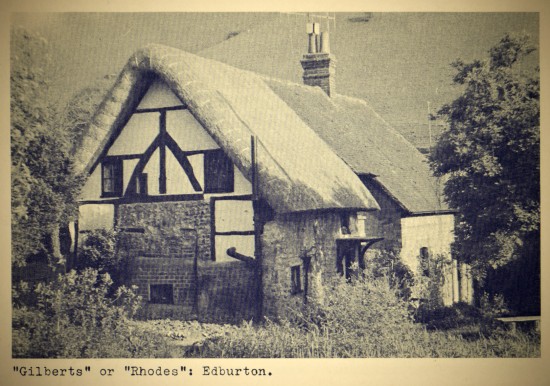
The village historian will have collected a mass of records from many sources. Some of these may convey little information, but now and then a new source is tapped, and quite a lot of the items suddenly fall into a connected story. I have had just such an experience concerning Edburton. Recently the Sussex Archaeological Society published a complete list of the deeds in its possession. Several of these referred to Edburton and some of them I had not seen. They proved to include nine deeds relating to the transfer of a copyhold property[1] referred to first in 1734 as a “messuage, garden and lands, late Gilberts in Aberton” and in later deeds as “late Rhoades” (or Rhodes). The place was evidently described, as places still often are, by the names of the owners, as we should say “Gilberts” house or “Rhode’s cottage”.
The earliest of the set of deeds to which I have referred is a court roll for Gilberts, dated 1734, when the copyholder, Thomas Street, died and left the property to his widow, Anne, and on her death to their son Thomas. The roll satisfied this and “admits” the new owners to possession.
The next rolls show Hannah’s eldest son, William, inheriting the property on her death in 1790, and he in turn leaving at his death in 1819 to his sister Ann, who had married Thomas Lee of Bletchingly in Surrey. She at once sold it to George Marshall, wheelwright, of Poynings, for eighty pounds. The last roll of this series shows it passing when George died in 1839 to his daughter Susan, wife of Thomas Walls a confectioner of Brighton.
Here arises a difficulty, for there is a parallel set of rolls concerning the descent of “a customary messuage or tenement, garden, lands and premises late Rhode’s, and theretofore Gilbert’s”, through three generations of the family of Gallup. On the evidence of these rolls this property passed to John Gallup in 1789, and on his death in 1797 to his grandson, John, an infant, in the guardianship of the boy’s father William. In 1819 this property, like Ann Lee’s, passed to George Marshall. Both the 1819 rolls bear the same date, 21st January, so we may assume that Marshall bought both properties. The most reasonable explanation is that this second property was the second (middle) cottage, added in the eighteenth century to the older one at the north end, which was Barters.
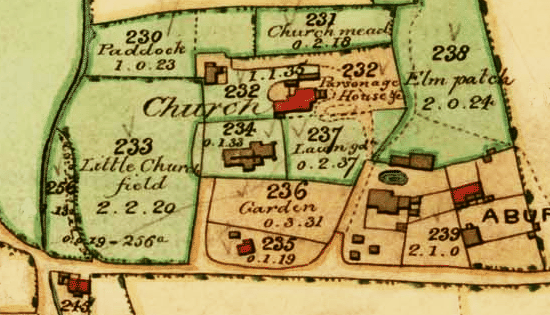
Plot 235 contained the three cottages, separately occupied by John Holding, William Mawley and Thomas Parker. No. 236, the northern part of the site, was separately held by James Cuttress, and is described as “garden”. Maps of a later date show this section hedged off from the cottage end, and the line of this hedge can still be made out.
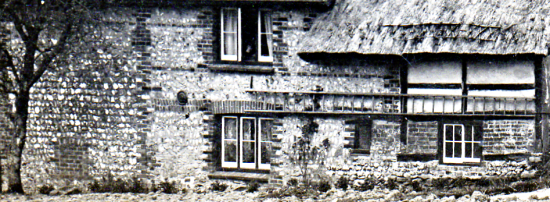
The eastern elevation of Rectory Cottage, c1900. Its origin as a terrace of three cottages each built at a different time is rather evident from the wall.
Next we can see George Barber, the nonagenarian, with his wife Frances and the unfortunate Hannah and her husband and children, and Hannah returning home in her widowhood to live with her son William until she died at the ripe age of seventy-two.
While these lived their lives in the oldest cottage, next door in the newer, but still ancient second cottage, old John Gallop saw his daughter married to a Woodmancote shoemaker, and when he died, we see his son William caring for his young son, another John, whose house by now it was, and how that William became Churchwarden (1802-1804), how he lost his wife and married again, and at last was laid to rest in 1831 at the age of 75 in the grave nearest the south porch of the church, where, as the headstone still enigmatically announces, “on either side lieth the remains of each of his two former wives”[3].
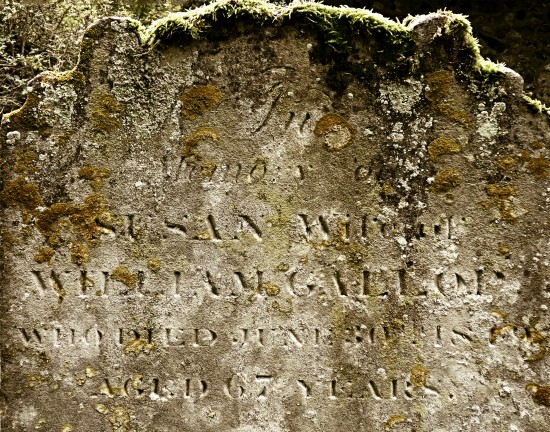
‘In memory of Susan, widow of William Gallop, who died 30th June 1849 aged 67 years’ — gravestone in Edburton churchyard, right of porch.
F.A. Howe, 1956
Footnotes
[1] As is to be expected in a community with such strong manorial traditions, many of the smaller dwellings were held by copyhold tenure until its abolition in 1926. They derive from the villeinage of the manors, and are historically the estates which became the property of the freed villeins who became the small farmers, the ‘yeomen’ or ‘husbandmen’ of later description. Copyhold property was not transferred as freehold property was, by title deeds, but at each transfer, whether by inheritance or otherwise, by a decision of the court baron of manorial tenants summoned by the steward of the manor and recording its witness to the transfer of the property to its new owner in a deed called a court roll. [The text of this footnote is taken from Howe 1958, page 33 and replaces the corresponding paragraph in Howe’s earlier 1956 article.]
[2] Members of the Barber family were still living in the parish a century later.
[3] This headstone had either disappeared or become illegible by 1991 when Joan Harris compiled the Edburton graves ledger. Howe does not remark on how truly strange the inscription is: William Gallop’s widow was to outlive him by eighteen years. The inscription must have been added to his stone after her death in 1849. But by whose instruction?
[4] James Cuttress deposed as follows [in 1843]:
I am 46 years of age. I used to tend sheep for Mr. Goddard, tenant of Robert’s farm. I was then seven years old. I tended them in Fulking Lane. They went out into Holmbush Lane. Mr. Charles Marchant saw them, drove them back and threatened to horsewhip me. He said it was out of Fulking Parish and they should not go there. He then occupied Brooklands which is half in Woodmancote.
Thus, at the beginning of the nineteenth century, were small children exploited.
[The text of this footnote is taken from Howe 1958, page 29.]
References

The Shoreham Herald is reporting:
Small Dole firm Truffles bakery, which has branches in Shoreham and Steyning, lost £19,600 when its NatWest account was raided in a phishing scam. .. Criminals got into the company’s computer using a virus planted in a fake email from HMRC. When the email was opened, the fraudsters could view data being input on the computer, including the firm’s online-banking password and pin code. .. General manager Gabby Taylor made an online payment on Friday, September 20, and found on the Monday morning the money had gone. .. She said: “We are gutted. We employ nearly 200 local people who are paid weekly and this has taken a huge amount out of our cash flow”.
Fulking Parish Council will hold an Planning Meeting on Wednesday 6th November 2013 at 6.30pm in the Village Hall
TO CONSIDER THE FOLLOWING PLANNING APPLICATIONS:-
SDNP/13/0487/FUL
Downside, Poynings Road,Fulking,Henfield,BN9 9NB
Renewal of current planning permission, proposed extension of front and side of existing main house. REF 10/03725/FUL 24th January 2011.
Full information available on the South Downs National Park Website – here
SDNP/13/04678/HOUS
Pippins,Poynings road, Fulking, Henfield, BN5 9NB
Replace 2 x storage sheds with 1 x hay shed 1 x potting shed and 2 x sheep sheds for housing ewes at lambing time.
Full information available on the South Downs National Park Website – here
SDNP/13/04875/TCA
Chimney House, The Street, Fulking,Henfield BN5 9LU
Conifer (T1) remove completely as tree is too large and too close to neighboring property. Willow (T2) re-pollard due to re growth.
Full information available on the South Downs National Park Website – here
SDNP/13/04634/HOUS
Knole House, Clappers Lane, Fulking, Henfield, BN5 9NH
Two storey side extension and roof conversion along with internal & external alterations.
Full information available on the South Downs National Park Website – here

SDNP/13/04573/FUL
Littledown Farm, Holmbush Lane, Woodmancote, Henfield, BN5 9TJ
Demolition and replacement of a single storey dwelling house to form a 1.5 storey 4 bed house including a detached garage and swimming pool buildings.
Full information available on the South Downs National Park Website – here

Members of the Public and Press are invited to attend.
Members of the public are entitled to speak at the meeting for two minutes, by prior arrangement with the Clerk Mrs. Andrea Dickson , tel 01444 451060 at least 1 hour before the meeting. No more than two speakers for each application and two against.
Andrea Dickson
Clerk to Fulking Parish Council
12 Turners Mill Road
Haywards Heath
West Sussex
RH16 1NN
andreadicksonfpc@gmail.com

Bioblitz — The Devil’s Dyke great fungal foray: join us for a day of hunting and recording as many species of fungi as possible, across Southwick Hill, on the South Downs, near Brighton. A team of scientists will be on hand to identify and record all that is found. The order of the day: 10:00am Meet at The Mile Oak pub; Introduction to the day. 10:15am Go out hunting for fungi on Southwick Hill. 12:00 noon Lunch on the hill. 2:00pm. Finish off the day with a cup of tea and cake at Mile Oak farm tea shop (not provided). Finish survey with a quick round up of the days findings. Friday, 1st November 2013, 10:00am — 2:00pm.
Booking essential. More info here.

The Tottington Woodlanders need you:
Come along and have a go at coppicing.
You do not need any special tools as they are all provided, along with the training, however please wear suitable clothing and footwear for working outdoors. The most important thing is to bring a mug for the cuppa around the fire – the hot water, tea or coffee will be provided.
We always pair up newcomers or novices with volunteers who are experienced and training continues until everyone is comfortable that you can work safely unaccompanied. Some people previously have been worried that they may cut the wood to the wrong size or do something wrong. We are grateful for the assistance and it is unlikely that you could do any lasting damage.
The work starts at 9.30am on a Sunday morning and normally finishes around 1pm, but there is no requirement to be there at the start and still be there at the end.
The dates for coppicing:-
More information here.

The West Sussex County Times reports:
Sweeptech [have applied] to change the use of a site from a storage and distribution centre to a waste recycling facility off Shoreham Road, just south of Henfield and north of Small Dole, [it] will recycle 75,000 tonnes of waste per year collected from road sweeping and gully clearing. ..
Henfield resident Adrian Jessup lives just 100 yards from the proposed 22 acre site, also known as the Old Brickworks. “Sweeptech have said there will be 35 movements a day from the site onto Shoreham Road (A2037), which is situated on a bend that has no overtaking on it, and if they can’t go through Henfield or Small Dole they’ll have to take Horn Lane, a small treacherous road.” ..
Small Dole residents have battled waste facilities in the past, including Horton Landfill Site, which opened in 1991 and closed in 2011. Small Dole Action Committee member Chris Warren said residents are still ‘suffering the consequences of pollution’. “Small Dole seems to be a magnet for waste processing. It’s more than we need,” said Mr Warren. “We have had waste lorries for donkey’s years and there’s been damage done to the roads as a result. There will be a dozen residents directly affected by this.” Mr Warren said he is also concerned about the waste vehicles’ route, and claimed it could potentially affect Henfield, Woodmancote, Small Dole and Upper Beeding.
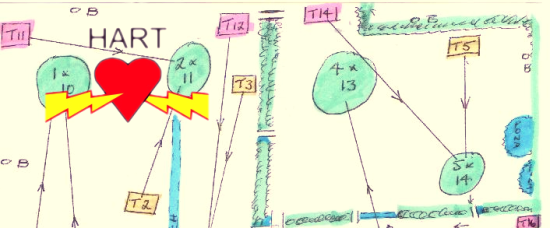
Every car needs a defibrillator:
Club member Malcolm Town collapsed while playing golf a year ago and was saved by his playing partner, HART responder Martin Tooth. Martin, who is club captain, happened to have his defibrillator in the car and was able to reach it in time to administer lifesaving treatment. HART are shortly to equip adjoining Henfield Business Park with a public access defibrillator.
More here.